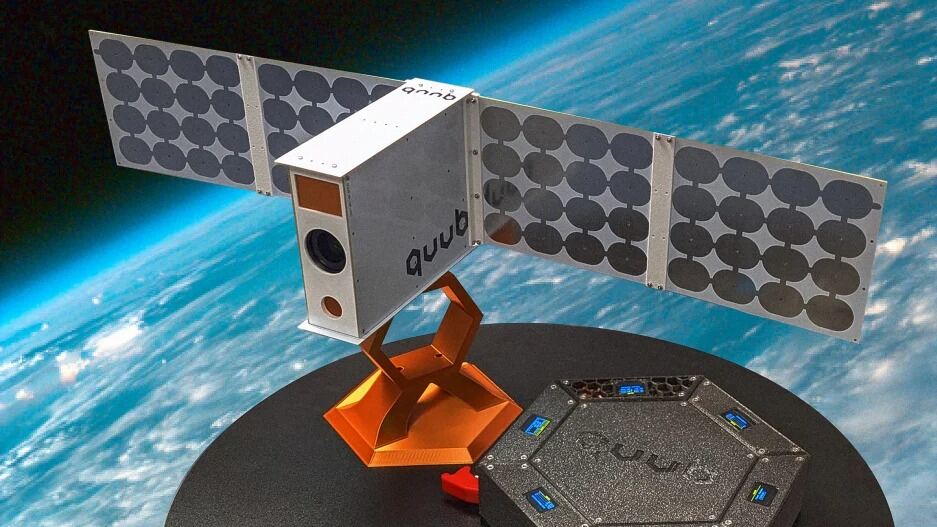- | 9:00 am
These swarms of tiny satellites could advance the fight against climate change
Redesigning satellites to be smaller, lighter, and cheaper is turning them into a ‘smartwatch’ for the planet.

The satellite on Joe Latrell’s desk is tiny. It stands shorter than a Gatorade bottle, and at 2.75 pounds weighs less than a small dumbbell. Latrell is the cofounder of Quub, a “data company” that designs and builds small satellites (also known as “smallsats”) that will someday circle Earth, taking the planet’s pulse.
“If a forest fire were to start in, say, the middle of California, we would spot it before anybody else does because the anomaly system would go off,” Latrell says, illustrating Quub’s mission.
Quub’s designs are a departure from the monolithic satellites of the past. They are environmentally friendly, made of circuit board, windform, and stainless steel screws that burn up when they reach Earth’s atmosphere, so nothing hits the ground. Latrell describes them as “space legos” that can be snapped together to form a flock of mini satellites.
A year ago, Quub was a one-man operation, but the company has since grown to 20 employees, contractors, and advisors. Quub already has two contracts with the Air Force—for Earth observation and exploring optical communication—and its satellites have yet to be fully deployed. With just one smallsat orbiting Earth now, it has a goal to get 400 up by 2025 and promises a data stream that will be updated every 15 minutes.
Latrell believes that someday his satellites will act as “a smartwatch for planet Earth,” tracking things like air quality, deforestation, and coastline erosion, the way a smartwatch health tracker monitors heart rate and sleep time. If water temperature changes, for instance, smallsats can pick up on the shift and help determine if the change is the result of a methane boom, for example, or from an industrial complex or a raw sewage dump. (“It happens more often than you want to know,” says Lattrell, who previously worked in water quality management.)
Quub is part of a bigger trend of smallsat deployments coming from companies including Planet Labs and Starlink. These smallsats, named for their relatively diminutive stature and low cost, are being used to track and fight the effects of climate change and natural disasters. Planet Labs’ SkySat satellite is 220 pounds, while its Dove satellites are about the size of a small printer. Both are deployed in low orbit, where they’ve already spent years monitoring wheat fields in India for a test that has tracked the efficacy of fertilizer-spreading methods. The multiyear study, led by researchers at the University of Michigan, found how to increase yield gains, but it was also a proof point in how these scalable, low-cost satellites could find answers to pressing environmental questions.
To compensate for their limitations in power and propellant, smallsats travel in packs of hundreds or even thousands known as “constellations,” which can easily be replenished thanks to low-cost rocket launches. Smallsats capture images more frequently than older, bigger satellites. As a point of comparison: Landsat, NASA’s long-running satellite program with the U.S. Geological Survey, updates every 16 days, while SkySat promises multiple visits every day. The increased revisit capacity means smallsats have the capability of spotting things before humans do.
The trend toward smaller satellites began, thanks to academia. Some of the earliest examples of small satellites came out of Stanford University and California Polytechnic State University, where professors Bob Twiggs and Jordi Puig-Suari pioneered the concept of a CubeSat, or small research satellites intended for low-Earth orbit.
They found that the yearslong lifecycle of a scientific mission wasn’t conducive to teaching students, who would only be in school a few years. Research satellites once took so long to build that by the time they launched, their technology could be anywhere from 5 to 10 years old.
In recent years, launches have been dominated by private companies, driven by an emerging commercial space industry, referred to as “NewSpace.” Smallsats hitch a ride on private rockets, like the SpaceX Falcon 9 that Quub used to launch a test satellite for a client in 2022.
Smallsat launches are growing, and fast. In 2019, more than 400 spacecraft launched—a figure that increased to more than 1,800 by 2021, according to Bryce Tech, an analytic consulting firm. Nine out of 10 of the spacecraft launched were smallsats, and a majority were for Starlink—the growing SpaceX mega constellation of more than 3,000 satellites. Starlink satellites provide internet service for Ukraine, and they’re sometimes spotted traveling in a straight line across the night sky.
The smallsat boom is expected to continue, with constellations from China and the European Union in the works. Starlink was approved for up to 7,500 satellites last year by the Federal Communications Commission, but SpaceX was even more ambitious, asking for 30,000.
The technology is obviously of interest for national defense, but when it comes to climate change and disasters, smallsats represent a promising development—giving mankind more data, faster. As humans look to orbit for answers to problems back on Earth, environmental conditions that once outpaced our ability to observe them in real time could soon be more closely tracked.






































